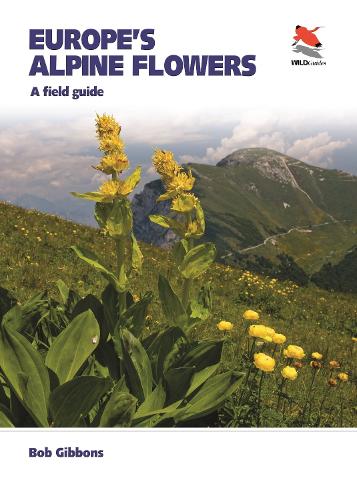Europe’s Alpine Flowers, Bob Gibbons (Princeton University Press/WILDGuides, 2025) ISBN: 9780691230788 £25
Reviewed by Dr Chris Gibson

Bob Gibbons is a name that any naturalist will know: as tour leader, author and especially a remarkable botanical photographer. This book was at an advanced stage of preparation before Bob sadly died in 2024, but thankfully his foray into writing a book to help others identify the Alpine flowers of Europe has now become a reality, expertly guided to fruition by the WILDGuides editorial team, assisted by Peter Marren and Richard Mabey.
There can be few botanists who are not fascinated by alpines, in the broadest sense of montane species and high Arctic plants, ones that grow in extreme habitats, where cold, wind and wet are all too frequent, such that they must have particularly showy flowers to attract the often sparse (or torpid) pollinators. Even those naturalists who never set foot in mountains or the far north have the opportunity to become entranced as alpines are a staple of rock, gravel and scree gardens at all altitudes and latitudes.
At first glance this is a book clearly from the by now tried-and-tested Princeton WILDGuides stable, with sturdy binding and flexicover, relying upon numerous photos with limited text to present information in an authoritative way. It covers some 1,800 species, but wisely doesn’t extend its purview much south of the Alps and the Pyrenees. The alpine regions of southern Europe beyond the geographic scope of this book do share many of the species covered here, but in addition they are a hotbed of endemism, featuring a multiplicity of species that are often restricted to very small areas, often single mountains or even single valleys. To include all of those in what is already quite a hefty book would certainly take it out of the realm of being a guide for use in the field.
Most of the photos used, typically one per species, come from Bob’s collection. For me Bob’s skill as a photographer was to be able to capture the place as well as the plant, and in many of the photos used that is apparent. But in the context of a field guide, it can also be a bit of a problem: to show the plant in its place may mean the plant is actually a rather small image, and the flowers smaller still such that they lose some of their value in identification. I feel there might have been a case to trim the text entries further and utilise any white space to include some close-up flower images in addition to the large image. Of course, the sourcing of additional images might have been more problematic following Bob’s death.
There are some places where there is signposting within the text to aid identification, in the form of the flagging of subdivisions based upon flower form, or leaf form, or even in some cases geographic localisation. Such rudimentary keys that help to restrict the choices in making correct identifications are incredibly useful, and the book would have benefited from more widespread application of this approach.
In a book of this nature, with so many species and photos there are always going to be errors. Thankfully I noticed rather few, although one such is the picture purporting to be Globularia repens on p315 that most certainly isn’t. Sad Stock (p196) is wrongly omitted being found in the Pyrenees. Erodium manescavi (p173) is incorrectly called manescavii and bizarrely given the English name of ‘Stork’s-bill’, surely more appropriate to the genus. And on p456, we find both ‘Bird’s-nest Orchid’ and ‘Violet Birds Nest Orchid’. Punctuation and consistency matter!
And while I am nitpicking, I would like to see more uniformity in the descriptions of geographic range, such that one is not faced with confusion such as on p150 where Dwarf Buckthorn is distributed ‘from the Pyrenees east to Austria and Slovenia’ but the next species Rock Buckthorn is distributed ‘from the Carpathians west to the Pyrenees’. With a little rewording, such directional mismatch could have been easily avoided.
So, will I use the guide the next time I visit one of the areas covered. Most certainly! It is the only field guide of this comprehensiveness currently in print. The only serious competitor is the out-of-print Collins Pocket Guide to Alpine Flowers of Britain and Europe by Grey-Wilson & Blamey, albeit still readily available on the second-hand market. Both books cover approximately the same geographic area, although the Collins guide probably extend a little further east. The species coverage is comparable: I counted the numbers of three popular groups (orchids, gentians and saxifrages) and found the WILDGuide to cover marginally more species. Collins lacks even a rudimentary key, but being illustrated by paintings of course allows flexibility to show both flowers and fruit, even if a single photo could not do so: the benefits of that are clear for example in the Brassicaceae where seed pods are a crucial part of the identification process. One clinching point is weight: 1.1kg for the WILDGuide versus 570g for the paperback second edition of Collins. Weight must be a consideration when climbing mountains, so my answer might be to take both books, but carry Collins around while leaving the WILDGuide in the hotel room for further critical reference.
First published by the British Naturalists’ Association